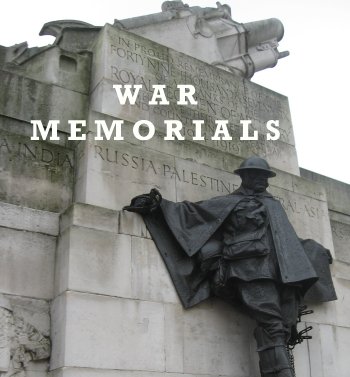
 |
Among London's many monuments, I was particularly interested in the war memorials, since I had become fascinated with them from afar while developing my World War II course. A major focus of the class was the relationship of London during the war and the London my students and I were living in, and memorials are an easy way, in fact an inescapable one, of making this connection.
To read more details about my impressions of the memorials, see these Favorite Fotos blog entries: In Memoriam, part 1 • In Memoriam, part 2 . This Flickr set contains larger versions of the photos on this page, plus many more. You can also see many more photos of the settings where many of the memorials reside, in the Parks section of this website. Memorials of various kinds are featured as well in the other sections of the website. In particular, check out the temporary memorials at Westminster Abbey on Remembrance Sunday, and photos from the parade I attended that day, a sort of living war memorial.
The UK National Inventory of War Memorials estimates that there are 70,000 memorials across the U.K. I'll admit I didn't even scratch the surface of this sea of commemoration, but was very impressed with the memorials in London and elsewhere that I was able to visit. Here are a few samples of the war memorials I saw outside of London:
Memorial at Earl's Colne Business Park, which was formerly an air base where my father was stationed for much of his World War II time in England |
Memorial in St. Giles church, Edinburgh |
Memorial inscription at the Scottish National War Memorial in Edinburgh Castle
|
Memorial in the small Norman church in Avebury |
Of course, in some way, all of London is a war memorial. Some physical evidence of the Blitz' ferocity has been left visible on purpose, such as the blast marks on the base of the sphinx near Cleopatra's Needle that I note in this blog post. But the new London is as much a reminder of this grim past as the old, as Anna Quindlen astutely remarks in Imagined London:
| "what the guidebooks cannot tell is how the newer buildings rose there. ...in London much of the modern rises on the bones of the antique because the antique was blown away in the Blitz. It is one of those moments when what has vanished teaches more than what remains." |
The Blitz was London's major World War II experience, and the Battle of Britain is intimately connected with it. There is a particularly fascinating modern memorial that commemorates both events right in the middle of tourist-London, on the Victoria Embankment just downstream from Big Ben. It features relief sculptures depicting various aspects of the air war over Britain and the impact of the Blitz on the ground. Here is the main section, honoring the pilots, air crews, and other support personnel who fought off the Luftwaffe when things looked bleakest.
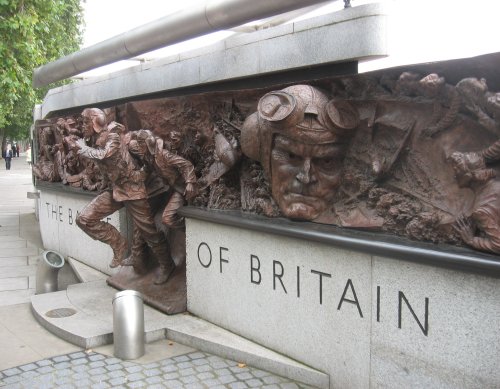 |
|
| Here are two of the other reliefs, the one on the right showing St. Paul's standing amid the surrounding devastation during the Blitz. Underneath the sculptures in these photos you can see parts of Churchill's famous commendation of the Battle of Britain pilots: "Never in the field of human conflict was so much owed by so many to so few." The memorial includes lists of the "few's" names (nearly 3000) divided up by country of origin— they weren't all from England. Even some Americans took part. | |
 |
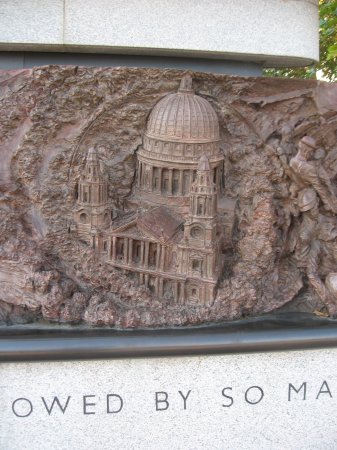 |
The Battle of Britain memorial is an outstanding example of what I call the "modern" style of war memorial. It's not difficult to contrast these newer structures with the "old" style monuments, most of which were erected in the period between the World Wars. Here are three examples of the latter, including the most famous, the Cenotaph, on Whitehall, which we walked past one evening. (Although the Wikipedia article linked here doesn't recognize San Antonio's Cenotaph, you can read about it here, in the Handbook of Texas.) On the right is the Cavalry Memorial in Hyde Park and on the left, a memorial to the Machine Gun Corps in Wellington Plaza.
 |
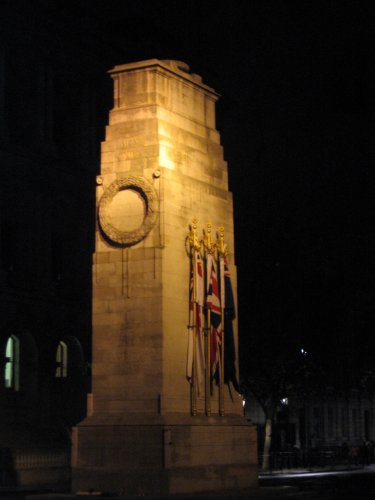 |
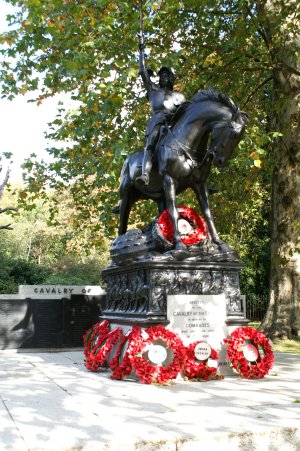 |
Another old-style memorial that nonetheless features a more modern sensibility is the Artillery Memorial in Wellington Plaza. Contrast it with the Gunner's memorial, in the same space, above. Here are sculptured figures that have a more naturalistic and melancholy air about them, in spite of the heroic prose of the main inscription:
In Proud Remembrance Of The
Forty-Nine Thousand & Seventy-Six
Of All Ranks Of The
Royal Regiment of Artillery
Who Gave Their Lives for King
And Country in the Great War
1914-1919
Like many memorials erected after the Great War, this memorial has additional panels honoring the World War II artillerymen dead. No need to build another large edifice when you have one as impressive as this to add to.
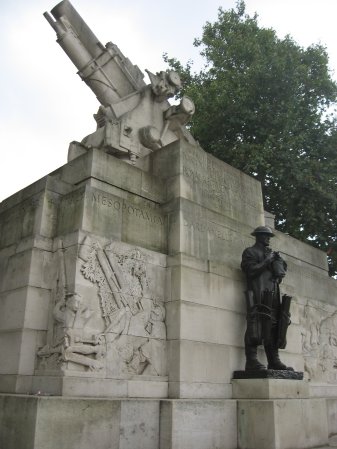 |
|
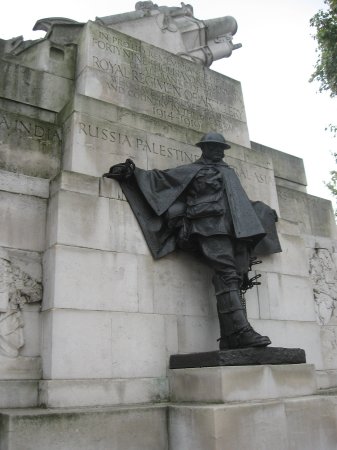 |
||
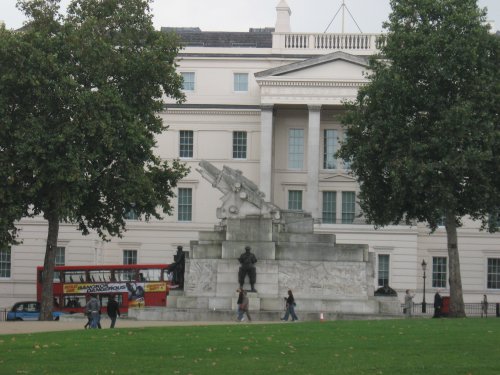 |
||||
Wellington Plaza is certainly "war memorial central," as I noted in the blog. Since it is also a stopping off place for many buses whose routes I frequented, I was able to visit it often. Here are two more memorials in the Plaza, these definitely in the modern style. They are extremely effective pieces of public art. On the left just below is the Australian Memorial, with its ghostly echoes of the many places Aussies came from, and where they fought, in support of the mother country, as the inscription describes:
Whatever burden you are to carry
We also will shoulder that burden
On the right is the equally striking New Zealand Memorial. On top you can see most of its 16 separate standards, each expressing a detail related to New Zealand's identity, relationship with Britain, and their shared wartime experiences. On the bottom right is a detail on one of them, calling attention to the island-nation's location, in the Antipodes so far away.
The other memorial in this grouping honors another member of the Commonwealth, Canada. The structure isn't in Wellington Plaza, but is not far away, in Green Park, another locale I visited often. I love the design of this memorial, combining aspects of fountain and sculpture in a most harmonious interaction with its lovely setting. There is an inscription on it that likewise highlights the bonds between mother country and "offspring":
In two world wars one million Canadians came to Britain and joined the fight for freedom
From danger shared, our friendship prospers
 |
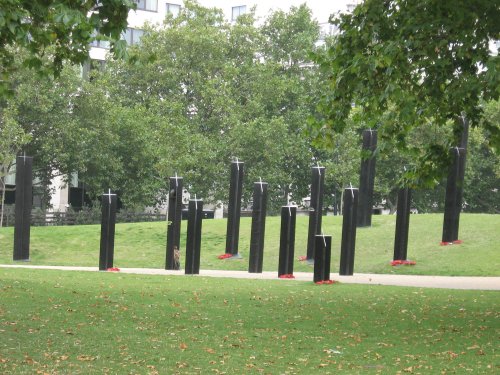 |
 |
 |
These two memorials honor the sacrifices of two very different groups of people who, nonetheless, each contributed substantially to the peaceful condition of modern Britain. On the left is the Commonwealth Memorial, particularly honoring soldiers from India, the countries that grew out of India, and the surrounding areas. It's located just across the street from Wellington Plaza, also in Green Park. At the right is the Soviet Citizens Memorial on the grounds of the Imperial War Museum, honoring the unimaginable numbers of Soviet soldiers and civilians who died in the struggle with nazism.
 |
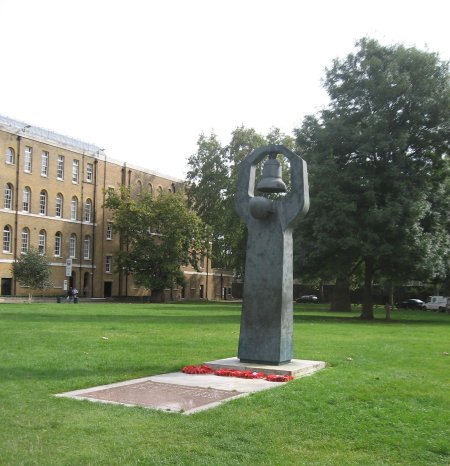 |
Another of my favorite "old style" memorials is this one on the Victoria Embankment, fittingly not far from the Battle of Britain Memorial. It honors the RAF (Royal Air Force) and was erected after the First World War, when air power was just in its infancy. In addition to the RAF's motto, PER ARDUA AD ASTRA ("Through Struggle to the Stars"), the inscriptions include the common addition of homage to the lost of World War II.
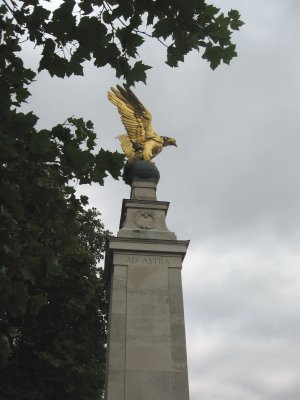 |
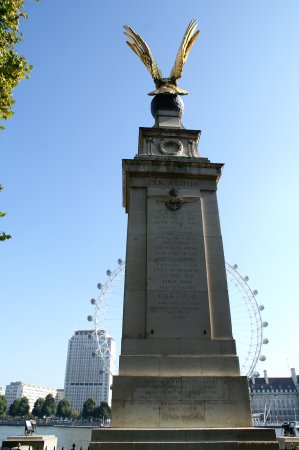 |
These two memorials also honor special groups who contributed to Britain's war efforts. On the left is the Firefighters Memorial, appropriately enough very near to St. Paul's, whose iconic structure the fire watchers kept from ruin during many nights of incendiary bombing during the Blitz. An even more specialized, and certainly quite unusual, memorial, is the one on the right, on the eastern edge of Hyde Park. It honors Animals in War who, in the words of the inscription: "had no choice" but to serve, and often die, for king and country.
 |
 |
A more traditional memorial is this one, honoring the Horse Guardsmen who fell at Ypres and on other World War I battlefields. The memorial faces the large expanse of the Horse Guards Parade, right in between St. James' Park and Whitehall.
 |
 |
Here we have examples of memorials honoring very specific campaigns and their heroes. On the left is the Malta Memorial, notable in particular for the richness of its informational detail. And on the right is the monument in Bishop's Park dedicated to the International Brigade members from that neighborhood who volunteered to fight in the Spanish Civil War, that bloody "rehearsal" for World War II. I found these words on the memorial especially moving, calling to mind the sacrifices made during that dark period of history:
They went because their open eyes could see no other way
 |
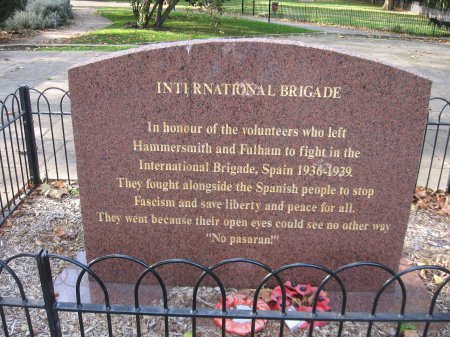 |
I'll close with one of the newest of London's memorials, a lovely park-like structure in Grosvenor Square near the American Embassy. It commemorates all those lost in the September 11th attacks. The inscription carved upon the wooden beam atop the columns reads: Grief is the Price We Pay for Love |
 |
 |
Back to Dream Season home • Back to London home